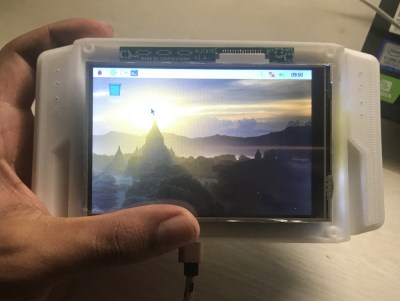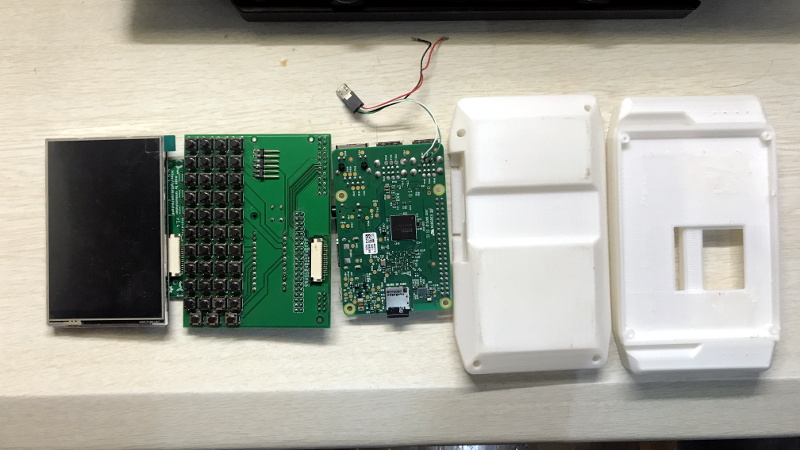Over the years we’ve seen the Raspberry Pi crammed into almost any piece of hardware you can think of. Frankly, seeing what kind of unusual consumer gadget you can shoehorn a Pi into has become something of a meme in our circles. But the thing we see considerably less of are custom designed practical enclosures which actually play to the Pi’s strengths. Which is a shame, because as the MutantC created by [rahmanshaber] shows, there’s some incredible untapped potential there.
 The MutantC features a QWERTY keyboard and sliding display, and seems more than a little inspired by early smartphone designs. You know, how they were before Apple came in and managed to convince every other manufacturer that there was no future for mobile devices with hardware keyboards. Unfortunately, hacking sessions will need to remain tethered as there’s currently no battery in the device. Though this is something [rahmanshaber] says he’s actively working on.
The MutantC features a QWERTY keyboard and sliding display, and seems more than a little inspired by early smartphone designs. You know, how they were before Apple came in and managed to convince every other manufacturer that there was no future for mobile devices with hardware keyboards. Unfortunately, hacking sessions will need to remain tethered as there’s currently no battery in the device. Though this is something [rahmanshaber] says he’s actively working on.
The custom PCB in the MutantC will work with either the Pi Zero or the full size variant, but [rahmanshaber] warns that the latest and greatest Pi 4 isn’t supported due to concerns about overheating. Beyond the Pi the parts list is pretty short, and mainly boils down to the 3D printed enclosure and the components required for the QWERTY board: 43 tactile switches and a SparkFun Pro Micro. Everything is open source, so you can have your own boards run off, print your case, and you’ll be well on the way to reliving those two-way pager glory days.
We’re excited to see where such a well documented open source project like MutantC goes from here. While the lack of an internal battery might be a show stopper for some applications, we think the overall form factor here is fantastic. Combined with the knowledge [Brian Benchoff] collected in his quest to perfect the small-scale keyboard, you’d have something very close to the mythical mobile Linux device that hackers have been dreaming of.
















I admit, I read in the title, the word “mutanic”
“mutanic” …Attack of the doomed mutant nautical passengers…only barely than the movies “Serial Ape-ist I and II” :-) …still if the popcorn and the company are good enough :-)
Sony Vaio UX Micro?
That’s exactly where I thought the inspiration came from. Loved that device before it went obsolete.
That was exactly my thought, when I saw it, too. I used mine to death, and was sad to see it go.
This is good in its simplicity. Any other additions or details can be left up to the imagination or “hacking” :)
Friend of mine let me know about this yesterday and I’ve started printing a case already. Could be interesting and useful.
If you get the chance it would be great if you can come back and let us know how it goes :-)
Just make a belt clip where it can live alongside a USB power bank, attached by an RGB USB cable. Done.
WindowMaker and all is good.
This looks neat. Not sure how long that tactile-switch keypad would last. Has anyone seen if the switches are properly debounced?
I’ve recently spotted the Dragonbox Pyra project, which may also classify as that “mythical mobile linux device.” From reading the forums it sounds like a LOT of development went into getting the hardware keyboard to feel Just Right. Plenty of ports and decent (removable) battery too! https://pyra-handheld.com/boards/pages/pyra/
(Not affiliated with the project, but I _really_ want one!)
Has it ceased being vaporware yet? I’ve wanted one for a long time (since the OpenPandora) but I haven’t heard of any deliveries. I think a simpler device, just the interface and battery that plugs into a phone, would do the trick and be easier to build/ship.
Yeah, I’ve been watching that project for years, it seems quite dead although there are people still avidly waiting.
The forums are still very active and the first pre-pre-orders have shipped, to software developers. Mass production will be “Real Soon Now” :-)
Didn’t those development versions ship about three years ago? The whole project has been “real soon now” the whole way through. When it was announced it was an exciting device, now it’s superseded by homebrew rasp-pi cases.
Hi. Very happy and excited to see my project featured here.
Here is a hands-on video https://youtu.be/j0_tIc-ElEM
The keys are very reliable as they are used in many devices and also if breaks they are easy replaceable.
I did not added battery because it needs some extra circuit that might be complicated to solder. I tried to make it as easy as possible that everyone can build one easily. There is a add-on that i am working one that will go with the expansion port it have. Also some other add-on like GPS, Radio, accelerometer etc or others anyone can make by themselves.
I’ve always wondered why nobody (as far as I know — please prove me wrong!) sells handheld raspberry pi enclosures with QWERTY keyboards. There are some of gaming handhelds with Raspberry Pis out there, but no keyboard is a dealbreaker (for me), and the PiTop laptop is too big (not handheld).
Yes, there was the PocketChip, OpenPandora, and soon the Pyra (mentioned above), but none of these are based on the RaspberryPi.
What gives? Is this something that doesn’t really appeal to many people? Or too expensive to make profitably?
I would imagine the size and power requirements of the Pi itself make it inconvenient. Consider how much space is required to accommodate the USB hub and Ethernet socket, and that you’re dealing with a current draw of 2.5 or 3 Amps, depending on model. You could base it on the 3A or the 0, but you lose the appeal of having a full Pi system.
I’d seriously consider a pi-top if they updated it to suit the Pi 4. A proper clamshell laptop with a pi 4 under the hood would come very close to filling the niche… Although the pocket-sized Pyra would fir the bill for something you’d never need to leave at home
The Raspberry Pi is a package deal. When you buy the board, you get the giant ethernet and dual USB stack. The board wasn’t designed with being as small as possible in mind, it was designed to be affordable and easy enough for children to get it up and running. You can modify the board, remove components that aren’t necessary, and throw it into a unique case. This doesn’t change that it wasn’t designed to be mobile. There is no onboard battery management. A qwerty keyboard case would have to have it’s own battery to power the bluetooth transponder, as you won’t likely want to plug in a giant USB cable for keyboard access. It’s just a messy way of solving a problem nobody asked for a solution to. On the flip-side, is it possible? Yes, of course. You can probably cannibalize those cheap portable bluetooth keyboard/trackpad gadgets. A few people have done that already with garage built devices.
With a bit of skill, you can replace the double-stack USB it with a 4×2 angled pin header, which is only slightly taller than a single USB port.
Its my endgame!! I only got this so far
https://hackaday.io/project/20937-pi0cket-clicker
This has me missing my Nokia n810
I had the n800, those were some interesting times. I stopped using the n800 when I got the first iPhone.
I would like to RPi 4 4GB Version perhaps with a fan. I do not have a 3D Printer so I will have to find someone to make it for me. Perhaps you could consider crowdfunding and make a finished cases all fully assembled for selling?
This is incredible
That would be great. but it is huge work. Not sure if i can do it alone.
HI. Just an update.
I made an add-on that lets you use your Arduino shield with mutantC using the expansion port.
Here is the [link] (https://gitlab.com/mutantC/add-on-arduino/tree/master)
This project keeps getting better and better – v4 looks great! Have you thought about doing a version that supports the Pi Compute Module? It might allow y0ou reduce the physical size a bit, while still keeping all the features…